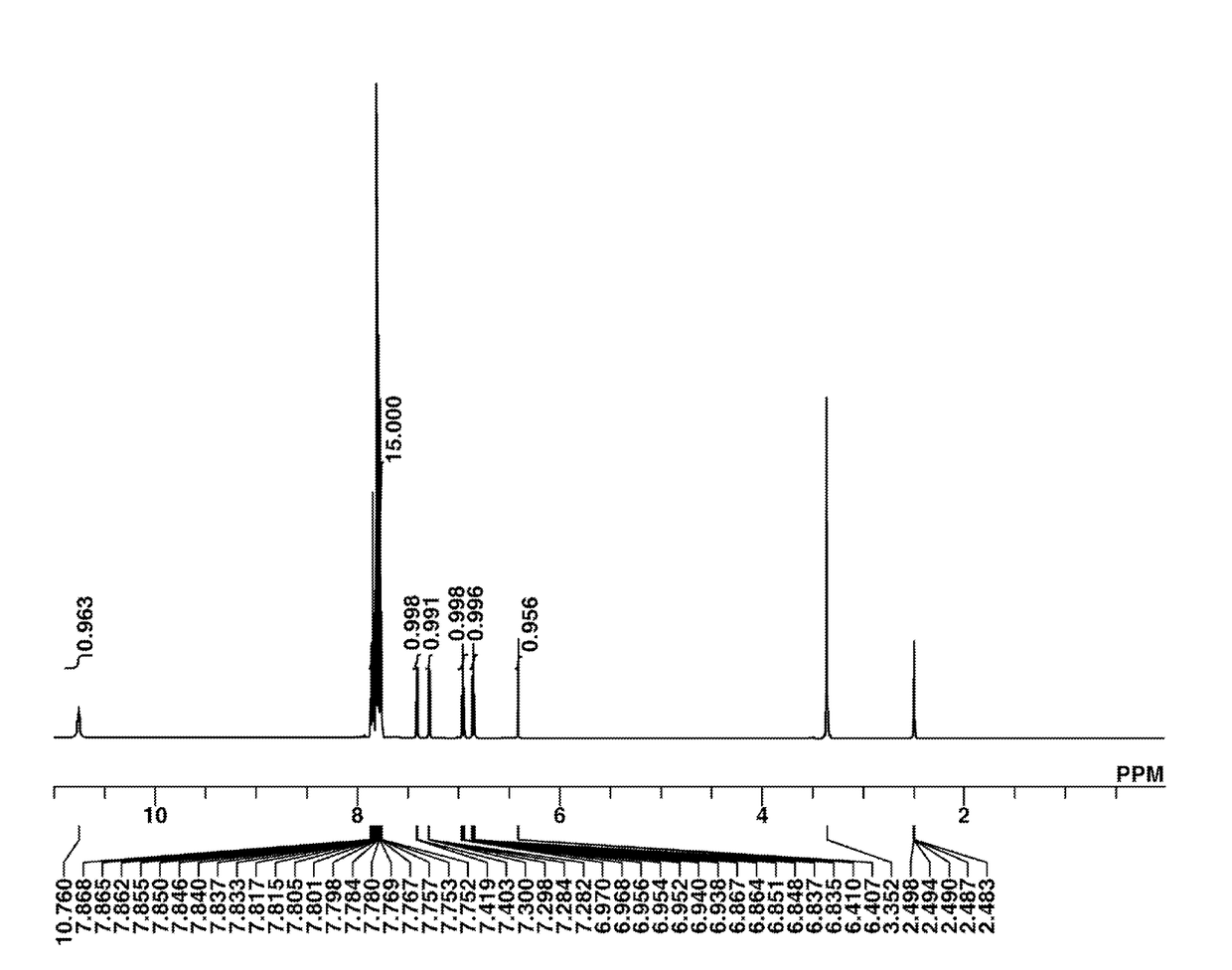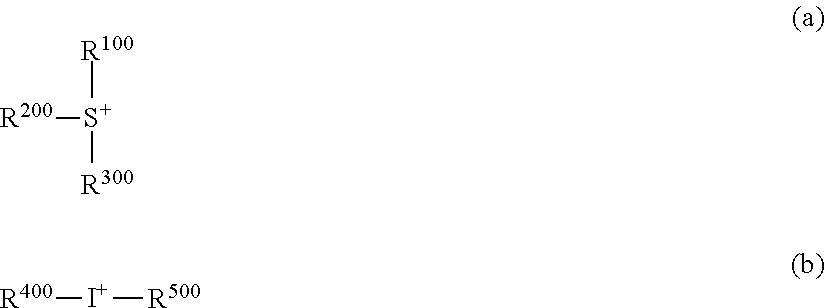Onium salt compound, resist composition, and pattern forming process
a technology of resist material and composition, which is applied in the field of resist composition and pattern forming process, can solve the problems of affecting the development the difficulty of forming the desired size of the resist material, and the technology still needs a resist material which is substantially non-leachable in water. achieve the effect of good profile, low mef, and high resolution
- Summary
- Abstract
- Description
- Claims
- Application Information
AI Technical Summary
Benefits of technology
Problems solved by technology
Method used
Image
Examples
synthesis example 1-1
Synthesis of triphenylsulfonium indole-2-carboxylate (Q-1)
[0186]
[0187]A mixture of 2.4 g of indole-2-carboxylic acid, 2.0 g of lead carbonate, 5.8 g of triphenylsulfonium iodide, and 30 g of methanol was heated and stirred at 70° C. for 8 hours. The reaction solution was cooled to room temperature and filtered. The filtrate was concentrated under reduced pressure. The solid precipitate was washed with methyl isobutyl ketone and dried under reduced pressure, obtaining 4.8 g of the target compound, triphenylsulfonium indole-2-carboxylate (yield 75%).
[0188]The target compound was analyzed by spectroscopy. The NMR spectrum, 1H-NMR in DMSO-d6, is shown in FIG. 1. In 1H-NMR analysis, a minute amount of water was observed.
Infrared Absorption Spectrum (IR (D-ATR): cm−1)
[0189]3389, 3135, 3083, 3022, 1574, 1523, 1474, 1445, 1415, 1382, 1371, 1340, 1320, 1230, 995, 844, 826, 816, 765, 755, 748, 699, 683 cm−1
Time-of-Flight Mass Spectrometry (TOFMS; MALDI)[0190]Positive M+ 263 (corresponding to...
synthesis example 2-1
Synthesis of Polymer P-1
[0193]In nitrogen atmosphere, 22 g of 1-tert-butylcyclopentyl methacrylate, 17 g of 2-oxotetrahydrofuran-3-yl methacrylate, 0.48 g of dimethyl 2,2′-azobis(2-methylpropionate) (V-601 by Wako Pure Chemical Industries, Ltd.), 0.41 g of 2-mercaptoethanol, and 50 g of methyl ethyl ketone were combined to form a monomer / initiator solution. A flask in nitrogen atmosphere was charged with 23 g of methyl ethyl ketone, which was heated at 80° C. with stirring. With stirring, the monomer / initiator solution was added dropwise to the flask over 4 hours. After the completion of dropwise addition, the polymerization solution was continuously stirred for 2 hours while maintaining the temperature of 80° C. The polymerization solution was cooled to room temperature, whereupon it was added dropwise to 640 g of methanol with vigorous stirring. The precipitate was collected by filtration, washed twice with 240 g of methanol, and vacuum dried at 50° C. for 20 hours, obtaining 36 g...
synthesis example 2-2 to 2-12
Synthesis of Polymers P-2 to P-12
[0195]Polymers were synthesized by the same procedure as in Synthesis Example 2-1 aside from changing the type and amount of monomers. Table 1 shows the proportion (in molar ratio) of units incorporated in these polymers, and Tables 2 and 3 show the structure of recurring units.
[0196]
TABLE 1Unit 1Unit 2Unit 3Unit 4Polymer(molar ratio)(molar ratio)(molar ratio)(molar ratio)P-1A-1 (0.50)B-1 (0.50)——P-2A-1 (0.40)B-1 (0.50)B-3 (0.10)—P-3A-1 (0.50)B-2 (0.20)B-3 (0.20)B-5 (0.10)P-4A-2 (0.40)B-1 (0.60)——P-5A-2 (0.40)B-2 (0.60)——P-6A-2 (0.20)A-3 (0.30)B-1 (0.40)B-5 (0.10)P-7A-2 (0.20)A-3 (0.30)B-2 (0.40)B-5 (0.10)P-8A-1 (0.25)A-2 (0.25)B-3 (0.40)B-5 (0.10)P-9A-1 (0.20)A-2 (0.25)B-1 (0.35)B-3 (0.20)P-10A-3 (0.25)A-5 (0.25)B-1 (0.35)B-5 (0.15)P-11A-4 (0.50)B-4 (0.50)——P-12A-6 (0.35)B-3 (0.65)——
[0197]
TABLE 2A-1A-2A-3A-4A-5A-6
[0198]
TABLE 3B-1B-2B-3B-4B-5
PUM
| Property | Measurement | Unit |
|---|---|---|
| refractive index | aaaaa | aaaaa |
| feature size | aaaaa | aaaaa |
| reaction time | aaaaa | aaaaa |
Abstract
Description
Claims
Application Information
 Login to View More
Login to View More - R&D
- Intellectual Property
- Life Sciences
- Materials
- Tech Scout
- Unparalleled Data Quality
- Higher Quality Content
- 60% Fewer Hallucinations
Browse by: Latest US Patents, China's latest patents, Technical Efficacy Thesaurus, Application Domain, Technology Topic, Popular Technical Reports.
© 2025 PatSnap. All rights reserved.Legal|Privacy policy|Modern Slavery Act Transparency Statement|Sitemap|About US| Contact US: help@patsnap.com



